Coffee is not just a drink, but a symbol of the cultural diversity and natural wealth of the archipelago. As one of the largest coffee producers in the world, Indonesia has various types of coffee that are famous for their distinctive flavors, aromas and characteristics. Each coffee-growing region in the archipelago has its own stories and traditions that reflect a strong local identity.
In 1696, the VOC governor in Malabar, India, sent Arabica coffee (Coffea arabica) seeds to Batavia (now Jakarta). These seedlings were planted around Batavia, but failed due to flooding. In 1699, new seedlings were brought back from Malabar and successfully grown in Batavia.
The Dutch began to expand coffee cultivation to higher areas, such as in West Java. Coffee from Java was first exported to Europe and became very popular there. This gave rise to the term “Java Coffee,” which is known to this day. Coffee plants then spread to areas such as Sumatra, Sulawesi, Bali and other islands.
Development of Coffee Cultivation in Various Regions
1. Aceh (Gayo Coffee)
Aceh, particularly the Gayo highland region, is one of the world’s top producers of Arabica coffee. Gayo coffee has a distinctive flavor with gentle acidity and floral aromas. Coffee cultivation in Gayo is done organically by small farmers who rely on traditional methods. This coffee is an export mainstay and has a large market in Europe and the United States. The coffee industry in Gayo is a source of livelihood for more than 70% of the local population, making it the backbone of Aceh’s economy.
2. North Sumatra (Mandailing Coffee)
North Sumatra is known for Mandailing coffee and Lintong coffee from the Mandailing Natal and Lintong Nihuta regions. A thick earthy flavor and smooth texture are the hallmarks of this coffee. Traditional processing techniques, such as wet hulling, give Mandailing coffee its uniqueness. The production of this coffee not only supports the local economy but also contributes to the preservation of agricultural traditions passed down through generations.
3. Bali (Kintamani Coffee)
Kintamani coffee from Bali is grown at high altitude with a traditional subak irrigation system. This coffee has a citrus and fruity flavor, which is attractive in the premium market. In addition to being a superior product, Kintamani coffee is also integrated with the agritourism sector. Tourists can visit coffee farms, witness the production process, and taste fresh coffee from the harvest. This provides additional income for local coffee farmers and supports the development of the tourism economy.
4. Sulawesi (Toraja Coffee)
Toraja coffee is one of the most famous Indonesian coffees in the world. The cultivation of this coffee is done traditionally by utilizing the local wisdom of the Toraja people. Toraja coffee has a complex taste with a thick body, often a favorite of the international market. The coffee industry in Toraja not only boosts the local economy, but also helps preserve Torajan culture, such as harvesting rituals involving the local community.
5. East Nusa Tenggara (Flores Bajawa Coffee)
Flores Bajawa coffee thrives in volcanic soil that is rich in minerals. This coffee is famous for its smooth chocolate and nutty flavors, as well as its balanced medium acidity. Coffee cultivation in Flores uses environmentally friendly methods, such as planting under the shade of forest trees. In addition to being the main source of income, coffee cultivation also encourages the development of ecotourism that invites tourists to get to know the coffee production process directly on the plantation.
The Impact of Coffee Cultivation on the Local Economy
1. Main Source of Income
Coffee cultivation is the backbone of the economy for millions of smallholder farmers in Indonesia. Most coffee farmers depend on the coffee harvest to make ends meet. In many areas, coffee is one of the main commodities that support the livelihood of farming families.
2. Job Creation
The coffee industry creates jobs in various sectors, from cultivation, harvesting, processing, to marketing. Many micro, small, and medium enterprises (MSMEs) engaged in the coffee sector, such as local cafes, roasters, and distributors, provide significant economic impact.
3. Increased Exports
Indonesia is one of the world’s largest coffee exporters, with specialty coffee having a high market share. Coffees such as Gayo, Mandailing, and Toraja are often favored in the international market. Coffee exports not only generate foreign exchange for the country but also have a direct impact on the economy of producing regions.
4. Agritourism Development
Regions such as Bali, Flores and Toraja have utilized coffee cultivation as a tourist attraction. Local and foreign tourists can see the coffee production process, from planting to serving. This agro-tourism not only increases farmers’ income but also introduces Nusantara coffee to the world stage.
5. Environmental and Cultural Preservation
Coffee cultivation is often associated with environmental conservation, especially if it is done organically and sustainably. On the other hand, local traditions such as coffee harvesting rituals in Toraja or the subak system in Bali are also preserved as part of the culture. This gives added value to local coffee products.
Nusantara coffee is more than just a commodity; it is a cultural heritage that connects us to history, nature and local traditions. The diversity of flavors and aromas originating from various regions in Indonesia is proof that coffee is an important part of the nation’s identity. By preserving and promoting Nusantara coffee, we are not only preserving our cultural wealth but also strengthening Indonesia’s position in the global arena. Hopefully, this article can inspire us to love and support Nusantara coffee as one of Indonesia’s pride.









